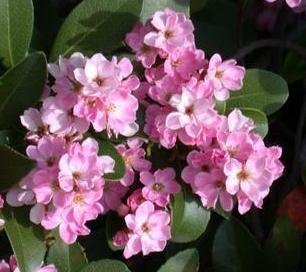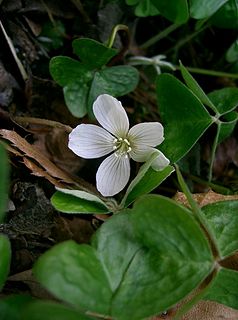Pachypodium ambongense belongs to the dogbane family Apocynaceae, which has recently been merged with the milkweed family Asclepiadaceae. It was first published as a species of the genus Pachypodium in 1924 by the botanist Henri Louis Poisson.

Stachys byzantina is a species of Stachys, native to Turkey, Armenia, and Iran. It is cultivated over much of the temperate world as an ornamental plant, and is naturalised in some locations as an escapee from gardens. Plants are very often found under the synonym Stachys lanata or Stachys olympica.

Cephalotaxus fortunei, commonly called the Chinese plum-yew, Fortune's yew plum, simply plum yew, Chinese cowtail pine or in Chinese as san jian shan, is a coniferous shrub or small tree in the family Taxaceae. It is native to northern Burma and China, but is sometimes grown in western gardens where it has been in cultivation since 1848.

Eurybia divaricata, commonly known as the white wood aster, is an herbaceous plant native to eastern North America. It occurs in the eastern United States, primarily in the Appalachian Mountains, though it is also present in southeastern Canada, but only in about 25 populations in the provinces of Ontario and Quebec. In the U.S. it is abundant and common, but in Canada it is considered threatened due to its restricted distribution. It can be found in dry open woods as well as along wood-edges and clearings. The species is distinguished by its flower heads that have yellow centers and white rays that are arranged in flat-topped corymbiform arrays, emerging in the late summer through fall. Other distinguishing characteristics include its serpentine stems and sharply serrated narrow heart-shaped leaves. The white wood aster is sometimes used in cultivation in both North America and Europe due to it being quite tough and for its showy flowers.

Rhaphiolepis indica, the Indian hawthorn, India hawthorn or Hong Kong hawthorn is an evergreen shrub in the family Rosaceae.
Cotoneaster tenuipes is an "extremely graceful," meter-high, hirsute, deciduous cotoneaster shrub endemic to the temperate regions of China. It was named and described by botanists Alfred Rehder and E.H.Wilson in 1912.
Salvia wardii is a perennial plant that is native to Tibet, found growing in alpine grasslands and thickets at 3,600 to 4,500 m elevation. It grows 50 to 75 cm high, on strong stems that are glandular and hairy, forming into a thick spreading plant. It has many basal leaves that are ovate to subhastate, 7 to 16 cm long and 3.5 to 8 cm wide. The upper leaf is slightly ridged with short hairs, the underside has red glandular hairs, especially dense on the veins.

Pittosporum bicolor, commonly known as cheesewood or banyalla, is a flowering shrub or small tree of the Pittosporaceae family, and is native to south eastern Australia.

Solanum evolvuloides is a species of Solanum, which was first described in 2011 by Giacomin & Stehmann. Solanum evolvuloides belongs to section Gonatotrichum, a small group assigned to the Brevantherum Clade of the genus Solanum. It resembles Solanum turneroides Chodat, sharing with it heterandry, and Solanum parcistrigosum Bitter, with which it shares a similar habit and pubescence. Despite these similarities, the species can be recognized by its ovate-elliptic to cordiform leaf shape and more membranaceous leaf texture than the other species in the section, and stem, inflorescence axes, and calyx vestiture mainly composed of glandular hairs. Solanum evolvuloides is known to occur only in southeastern of Bahia state, Brazil, and in a preliminary assessment of the International Union for Conservation of Nature (IUCN) criteria can be considered a threatened species.

Meconopsis horridula, the prickly blue poppy, is a flowering plant from the Papaveraceae family. It is an endangered species that grows in high altitudes. The height of the plant varies from 20 cm to 1m. It is a monocarpic, dicot plant.
Ribes sanchezii is a species of currant, named after Peruvian botanist Isidoro Sánchez Vega of Cajamarca. This species of Ribes is distinct form both R. andicola and R. colandina because of its ovate to elliptical leaves with a very poorly developed lateral lobe and its aberrant indument. The two latter species have leaves with pubescence on both the adaxial and abaxial surface and the adaxial leaf surface is matt green, whereas R. sanchezii has a shiny dark green upper leaf surface and pubescence abaxially restricted to the primary and secondary veins. Ribes sanchezii also has strongly resupinate fruits, whereas the fruits of R. andicola and R. colandina are pendulous.

Oxalis griffithii is an Oxalis species found in thickets and meadows of Bhutan, China, India and Japan. Perennials 7–25 cm tall, stemless, pubescent. Rhizome creeping underground, entirely densely covered by dark brown scalelike remains of leaf bases, 6–12 mm thick including scales; scales strigose. Leaves basal; petiole 6–20 cm, pubescent, trichomes brown and curled; leaflet blades obtriangular, 1–2.5(–4.5) × 1.5–3.5(–5.5) cm, abaxially pubescent, adaxially glabrous, apex broadly emarginate to subtruncate; lobe apices obtuse. Flowers solitary, nodding; peduncle 4–15 cm, equal to or longer than leaves; bracts at middle of flowering stalk, lanceolate, 2.5–4 mm, with dense trichomes along midvein and margins. Sepals lanceolate, 5–7 mm, persistent. Petals white with lilac veins, rarely pink (Hubei), narrowly obovate, 1.2–1.6 (–2) cm, apex retuse to deeply emarginate. Capsule oblongconic, 5–13 × 5–6 mm. Seeds ovoid, 2.5–3.5 mm, longitudinally ridged. Mixed deciduous or coniferous forests, thickets, moist and dry shady places; 800–3400 m. found in China, Taiwan, Bhutan, India, Japan, Kashmir, Korea, N Myanmar, Nepal, Philippines.

Metaplexis is a genus of flowering plants in the family Apocynaceae, first described as a genus in 1810. As presently conceived, it contains two known species, both native to east Asia.
Syringa pinetorum is a species in the genus Syringa, in the family Oleaceae.

Syringa tomentella is a species in the genus Syringa, in the family Oleaceae.
Ilex asprella, also known as rough-leaved holly and plum-leaved holly, is a deciduous shrub native in South East Asia. Ilex asprella is one of the few deciduous species in the family Aquifoliaceae.

Prunus himalayana, called jyokun shin in Tibetan and 喜马拉雅臭樱 in Chinese, is a species of Prunus native to Nepal, Bhutan, Sikkim and Tibet. It prefers to grow 2,800 to 4,200 m above sea level in the Himalayas. As Maddenia himalaica it was the type species for the now unrecognized genus Maddenia.
Colona thorelii is a species small tree, in the family Malvaceae and now placed in the subfamily Grewioideae. No subspecies are listed in the Catalogue of Life.
Prunus mugus is a species of cherry found in Yunnan province of China and nearby areas of Myanmar and Tibet. A prostrate shrub 1 m tall, it prefers to grow in thickets in the krummholz zone on mountain slopes from 3200 to 3,700 m or even 4,075 metres (13,400 ft) above sea level. Heinrich von Handel-Mazzetti, who discovered it, named the species after Pinus mugo, the dwarf mountain pine.
Prunus dictyoneura is a species of cherry found in Gansu, Hebei, Henan, Jiangsu, Ningxia, Shaanxi and Shanxi provinces of China. A shrub 0.3 to 1.0 m tall, it prefers to grow in thickets in grasslands on hillsides from 400 to 1600 m above sea level. Chloroplast DNA sequencing has shown that its closest relative is Prunus prostrata, at least as far as chloroplasts are concerned.











